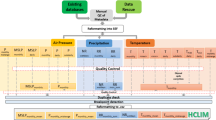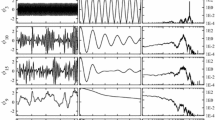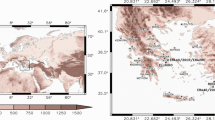Abstract
The Lamb weather type series is a subjective catalogue of daily atmospheric patterns and flow directions over the British Isles, covering the period 1861–1996. Based on synoptic maps, meteorologists have empirically classified surface pressure patterns over this area, which is a key area for the progression of Atlantic storm tracks towards Europe. We apply this classification to a set of daily pressure series from a few stations from western Europe, in order to reconstruct and to extend this daily weather type series back to 1781. We describe a statistical framework which provides, for each day, the weather types consistent enough with the observed pressure pattern, and their respective probability. Overall, this technique can correctly reconstruct almost 75% of the Lamb daily types, when simplified to the seven main weather types. The weather type series are described and compared to the original series for the winter season only. Since the low frequency variability of synoptic conditions is directly related to the North Atlantic Oscillation (NAO), we derive from the weather type series an NAO index for winter. An interesting feature is a larger multidecadal variability during the nineteenth century than during the twentieth century.





Similar content being viewed by others
References
Ansell TJ et al (2006) Daily mean sea level pressure reconstructions for the European-North Atlantic region for the period 1850–2003. J Clim 19:2717–2742. https://doi.org/10.1175/JCLI3775.1
Attmannspacher W (1981) 200 Jahre meteorologische Beobachtungen auf dem Hohenpeißenberg 1781–1980. Berichte Deutscher Wetterdienst 155, Offenbach am Main
Barriopedro D et al (2014) Witnessing North Atlantic westerlies variability from ships’ logbooks (1685–2008). Clim Dyn 43:939–955. https://doi.org/10.1007/s00382-013-1957-8
Beck C, Philipp A (2010) Evaluation and comparison of circulation type classifications for the European domain. Phys Chemis Earth 35:374–387. https://doi.org/10.1016/j.pce.2010.01.001
Beck C, Jacobeit J, Jones PD (2007) Frequency and within-type variations of large-scale circulation types and their effects on low-frequency climate variability in central europe since 1780. Int J Climatol 27:473–491. https://doi.org/10.1002/joc.1410
Bergström H, Moberg A (2002) Daily air temperature and pressure series for Uppsala (1722–1998). Clim Change 53:213–252. https://doi.org/10.1023/A:1014983229213
Branstator G, Selten F (2009) “Modes of variability” and climate change. J Clim 22:2639–2658. https://doi.org/10.1175/2008JCLI2517.1
Brönnimann S et al (2013) Historical weather extremes in the “Twentieth Century Reanalysis”. In: Brönnimann S, Martius O (eds) Weather extremes during the past 140 years. Geographica Bernensia, Bern, pp 7–17. https://doi.org/10.4480/GB2013.G89.01
Brugnara Y et al (2015) A collection of sub-daily pressure and temperature observations for the early instrumental period with a focus on the “year without a summer” 1816. Clim Past 11:1027–1047. https://doi.org/10.5194/cp-11-1027-2015
Compo GP et al (2011) The twentieth century reanalysis project. Q J R Meteorol Soc 137:1–28. https://doi.org/10.1002/qj.776
Cornes RC et al (2012a) A daily series of mean sea-level pressure for London, 1692–2007. Int J Climatol 32:641–656. https://doi.org/10.1002/joc.2301
Cornes RC et al (2012b) A daily series of mean sea-level pressure for Paris, 1670–2007. Int J Climatol 32:1135–1150. https://doi.org/10.1002/joc.2349
Cornes RC et al (2013) Estimates of the North Atlantic Oscillation back to 1692 using a Paris-London westerly index. Int J Climatol 33:228–248. https://doi.org/10.1002/joc.3416
Corti S, Molteni F, Palmer TN (1999) Signature of recent climate change in frequencies of natural atmospheric circulation regimes. Nature 398:799–802. https://doi.org/10.1038/19745
D’Arrigo R et al (2011) The anomalous winter of 1783–1784: Was the Laki eruption or an analog of the 2009–2010 winter to blame? Geophys Res Lett 38:L05706. https://doi.org/10.1029/2011GL046696
Ferguson CR, Villarini G (2013) An evaluation of the statistical homogeneity of the twentieth century reanalysis. Clim Dyn 42:2841–2866. https://doi.org/10.1007/s00382-013-1996-1
Goodkin NF et al (2008) Increased multidecadal variability of the North Atlantic Oscillation since 1781. Nat Geosci 1:844–848. https://doi.org/10.1038/ngeo352
Hertig E et al (2015) A review of non-stationarities in climate variability of the last century with focus on the North Atlantic—European sector. Earth Sci Rev 147:1–17. https://doi.org/10.1016/j.earscirev.2015.04.009
Hess P, Brezowsky H (1977) Katalog der Grosswetterlagen Europas 1881–1976, 3. verbesserte und ergänzte Auflage. Deutscher Wetterdienst, Offenbach am Main
Hurrell JW (1995) decadal trends in the north atlantic oscillation: regional temperatures and precipitation. Science 269:676–679. https://doi.org/10.1126/science.269.5224.676
Jenkinson AF, Collison FP (1977) An initial climatology of gales over the North Sea. U.K. Meteorological Office, Bracknell
Jones PD, Wigley TML, Briffa KR (1987) Monthly mean pressure reconstructions for Europe (back to 1780) and North America (to 1858). U.S. Dept. of Energy, Office of Energy Research, Carbon Dioxide Research Division, Washington, DC
Jones PD, Hulme M, Briffa KR (1993) A comparison of Lamb circulation types with an objective classification scheme. Int J Climatol 13:655–663. https://doi.org/10.1002/joc.3370130606
Jones PD, Osborn TJ, Briffa KR (2003) Pressure-based measures of the North Atlantic Oscillation (NAO): a comparison and an assessment of changes in the strength of the NAO and in its influence on surface climate parameters. In: Hurrell JW et al (ed) The North Atlantic Oscillation: climatic significance and environmental impact. American Geophysical Union, Washington, D.C., pp 51–62
Jones PD, Harpham C, Briffa KR (2013) Lamb weather types derived from reanalysis products. Int J Climatol 33:1129–1139. https://doi.org/10.1002/joc.3498
Jones PD et al (2014) The development of Lamb weather types: from subjective analysis of weather charts to objective approaches using reanalyses. Weather 69:128–132. https://doi.org/10.1002/wea.2255
Kington JA (1970) A late eighteenth century source of meteorological data. Weather 25:169–175. https://doi.org/10.1002/j.1477-8696.1970.tb05224.x
Kington JA (1988) The weather of the 1780s over Europe. Cambridge University Press, Cambridge
Krueger O et al (2013) Inconsistencies between long-term trends in storminess derived from the 20CR reanalysis and observations. J Clim 26:868–874. https://doi.org/10.1175/JCLI-D-12-00309.1
Lamb HH (1950) Types and spells of weather around the year in the British Isles: annual trends, seasonal structure of the year, singularities. Q J R Meteorol Soc 76:393–429. https://doi.org/10.1002/qj.49707633005
Lamb HH (1972) British Isles weather types and a register of daily sequence of circulation patterns 1861–1971. H.M. Stationery Office, London
Lamb HH (1994) British isles daily wind and weather patterns 1588, 1781–86, 1991 and shorter early sequences. Clim Monitor 20:47–71
Lamb HH, Johnson AI (1966) Secular variations of the atmospheric circulation since 1750. Meteorological Office, HMSO, London
Maugeri M et al (2002) Daily Milan temperature and pressure series (1763–1998): completing and homogenising the data. Clim Change 53:119–149. https://doi.org/10.1023/A:1014923027396
Michelangeli P-A, Vautard R, Legras B (1995) Weather regimes: recurrence and quasi stationarity. J Atmos Sci 52:1237–1256
Moberg A et al (2002) Daily air temperature and pressure series for Stockholm (1756–1998). Clim Change 53:171–212. https://doi.org/10.1023/A:1014966724670
Murray R, Lewis RPW (1966) Some aspects of the synoptic climatology of the British Isles as measured by simple indices. Meteorol Mag 95:193–203
Nicholls N (1980) Long-range weather forecasting: value, status, and prospects. Rev Geophys 18:771–788. https://doi.org/10.1029/RG018i004p00771
Ortega P et al (2015) A model-tested North Atlantic Oscillation reconstruction for the past millennium. Nature 523:71–74. https://doi.org/10.1038/nature14518
Osborn TJ et al (1999) Evaluation of the North Atlantic Oscillation as simulated by a coupled climate model. Clim Dyn 15:685–702. https://doi.org/10.1007/s003820050310
Perry A (1969) The P.S.C.M. index and regional anomalies of temperature, rainfall and sunshine. Weather 24:225–228. https://doi.org/10.1002/j.1477-8696.1969.tb03184.x
Schwander M et al (2017) Reconstruction of central European daily weather types back to 1763. Int J Climatol 37:30–44. https://doi.org/10.1002/joc.4974
Slonosky VC, Jones PD, Davies TD (2000) Variability of the surface atmospheric circulation over Europe, 1774–1995. Int J Climatol 20:1875–1897. https://doi.org/10.1002/1097-0088(200012)20:15%3C1875::AID-JOC593%3E3.0.CO;2-D
Sweeney JC, O’Hare GP (1992) Geographical variations in precipitation yields and circulation types in Britain and Ireland. Trans Inst Br Geogr 17:448–463. https://doi.org/10.2307/622710
Vinther BM et al (2003) Improving the Gibraltar/Reykjavik NAO index. Geophys Res Lett 30:2222. https://doi.org/10.1029/2003GL018220
Wallace JM (2000) North atlantic oscillation/annular mode: Two paradigms—one phenomenon. Q J RMeteorol Soc 126:791–805. https://doi.org/10.1002/qj.49712656402
Wanner H et al (2001) North Atlantic oscillation—concepts and studies. Surv Geophys 22:321–381. https://doi.org/10.1023/A:1014217317898
Werner PC, Gerstengarbe F-W (2011) Spatial-temporal changes of meteorological parameters in selected circulation patterns. Potsdam Institute for Climate Impact Research (PIK), Potsdam
Werner PC et al (2000) Recent climate change in the North Atlantic/European sector. Int J Climatol 20:463–471. https://doi.org/10.1002/(SICI)1097-0088(200004)20:5%3C463::AID-JOC483%3E3.0.CO;2-T
Wilby RL (1993) Evidence of ENSO in the synoptic climate of the British Isles since 1880. Weather 48:234–239. https://doi.org/10.1002/j.1477-8696.1993.tb05897.x
Wilby R (1995) Simulation of precipitation by weather pattern and frontal analysis. J Hydrol 173:91–109. https://doi.org/10.1016/0022-1694(95)02715-2
Wilby RL, Quinn NW (2013) Reconstructing multi-decadal variations in fluvial flood risk using atmospheric circulation patterns. J Hydrol 487:109–121. https://doi.org/10.1016/j.jhydrol.2013.02.038
Wilby RL, O’Hare G, Barnsley N (1997) The North Atlantic Oscillation and British Isles climate variability, 1865–1996. Weather 52:266–276. https://doi.org/10.1002/j.1477-8696.1997.tb06323.x
Wilks DS (2011) Chap. 11—the multivariate normal (MVN) distribution. In: Wilks DS (ed) Statistical methods in the atmospheric sciences. Academic Press, Cambridge, pp 491–518
Woollings T (2010) Dynamical influences on European climate: an uncertain future. Phil Trans R Soc A 368:3733–3756. https://doi.org/10.1098/rsta.2010.0040
Yiou P et al (2007) Inconsistency between atmospheric dynamics and temperatures during the exceptional 2006/2007 fall/winter and recent warming in Europe. Geophys Res Lett 34:L21808. https://doi.org/10.1029/2007GL031981
Acknowledgements
We are grateful to meteorologists who spent their careers analysing weather charts and compiling these data; and to ‘data savers’ who have exhumed and homogenised measurements of surface pressure and made them publicly available. We are also grateful to the reviewers who spent efforts and time to improve the manuscript. MS has been funded by the Swiss SNF project FUPSOL-2; SB acknowledges funding from the SNF project RE-USE. GD is indebted to the Institute of Geography, University of Bern, for hosting him during a sabbatical stay. Many thanks to the Scilab Consortium for providing the Scilab tool used for calculations and graphs.
Author information
Authors and Affiliations
Corresponding author
Appendix: details of the classification
Appendix: details of the classification
-
1.
Flow chart of the classification (example with the objective catalogue)

-
2.
Calculation of the centroids We combine the daily series of pressure measured at the available stations (Table 2) with the daily WTs of the Lamb catalogue (‘subjective’ catalogue herein), or of the Jones et al. catalogue (‘objective’ catalogue herein), to calculate the average normalised pressure at each station and for each WT (so-called ‘centroids’, Fig. 2).
-
3.
Explained variance (EV) The efficiency of the chosen centroids (seven main Lamb WTs) to statistically describe the pressure variability recorded at the stations is quantified with the standard metric of the explained variance (EV):
$${\text{EV}}={\text{BSS}}/{\text{TSS}}=1 - {\text{WSS}}/{\text{TSS}},$$(1)with BSS the ‘between-types-sum-of-squares’, WSS the ‘within-types-sum-of-squares’ and TSS the ‘total-sum-of-squares’ (e.g., Beck and Philipp 2010). For these calculations, unclassified days are not accounted for (accounting for them slightly decreases EV by 1–2%). Note that EV depends on the number of WTs considered, hence the values of EV calculated with 7 types are not directly comparable to the ones obtained with 26 types, or with other classification techniques (Beck and Philipp 2010).
-
4.
Distance between the daily pressure pattern and centroids For each day with pressure data at all stations (otherwise the day is considered as ‘unclassified’), we calculate the Mahalanobis distance Di between the measured pressure values and the centroids of the corresponding month for the WT i as the sum over the s stations (in matrix form):
$$D_{i}^{2}={\left( {{P_s} - {{\bar {P}}_i}} \right)^T} \cdot Cov_{i}^{{ - 1}} \cdot \left( {{P_s} - {{\bar {P}}_i}} \right),$$(2)where Ps is the (s × 1) vector of pressure values measured at the stations for each day, \({\bar {P}_i}\) is the (s × 1) vector of centroids (average values) for the weather type i, and Covi is the (s × s) covariance matrix between the pressure values measured at the stations calculated separately for each WT i (as defined in the catalogue).
-
5.
Probability distribution of the distance We use this distance Di as a metric of the probability distribution of distance to each centroid i. Since the pressure associated to each WT is approximately normally distributed, we assume that the square of the distance Di2 follows a chi-squared distribution (e.g., Wilks 2011), that is,
$$f\left( {{{\text{D}}_{\text{i}}}^{{\text{2}}}/{\text{ WT }}=i} \right){\text{ }}=f{{\chi}}_{\text{s}}^{{\text{2}}},$$(3)where f(Di2/WT = i) is the probability density of Di2 for the weather type i, and fχs2 is the probability density of the chi-squared distribution with s degrees of freedom (the number of stations).
-
6.
Classification consistency For each day we evaluate whether the observed pattern of pressure does correctly project onto one of the given seven sets of centroids, and so can be classified. For this, among the seven distances Di between the observed pressure pattern and the seven WTs, we evaluate whether the shortest distance Di is short enough to attribute this day to the corresponding WT i. The formal test is the following. The null hypothesis H0 to reject is that, for each day, the minimum distance Di is too large to attribute this day to any WT. Note that by considering the minimum distance for each day, we do not make an a priori hypothesis on the matching WT. We accept a risk of wrongly rejecting H0 of α = 1%. We have to compare the minimum value of the given day with the threshold value corresponding to the 1% of the empirical distribution of the minimum values for all days of the catalogue. For the objective catalogue over the 1861–1996 period, the value which leaves 1% of one-sided, right-tail, probability is 20.1, and is used as the threshold value to reject H0. (Note that this empirical distribution follows quite closely a Chi square distribution with 6 degrees of freedom.)
-
7.
Classification of each day If the above test is passed, that is, if there is at least one acceptable WT matching the observed pressure pattern of day j, then we want to calculate the probabilities of the different WTs to match this pressure pattern, Pj, that is, the conditional probabilities of WT i, given Pj : P(WTj = i/Pj). If day j has to be classified with only one WT, we use the ‘maximum a posteriori rule’ to find the WT i which maximizes the probability of the WT i given the pressure pattern Pj.
-
8.
Joint probabilities of WTs For each day j considered as reasonably close to the Lamb WTs, we would like to estimate the probability of each WT i to match the observed pattern of pressure Pj, that is, P(WTj = i / Pj).
Using Bayes formula and the law of total probability, we write that:
\(P\left( {W{T_j}=i/{P_j}} \right)=\frac{{f\left( {{P_j}/W{T_j}=i} \right).P\left( {W{T_j}=i} \right)}}{{f\left( {{P_j}} \right)}}\), and
$$P\left( {W{T_j}=i/{P_j}} \right)=\frac{{f\left( {{P_j}/W{T_j}=i} \right).P\left( {W{T_j}=i} \right)}}{{\mathop \sum \nolimits_{k} f\left( {{P_j}/W{T_j}=k} \right).P\left( {W{T_j}=k} \right)}}$$with k describing all WTs.
The probability of any WT i, P(WTj = i), is taken as the frequency of this WT over the whole catalogue, Fi.
Last, we assume that the squared distance of the pressure pattern to the centroids follows a Chi square distribution with s degrees of freedom (with s the number of stations), so that:
$$f({{\text{P}}_{\text{j}}}/{\text{ W}}{{\text{T}}_{\text{j}}}=i)\,=\,f{{\chi}_s}^{2}({{\text{D}}_{\text{i}}}^{{\text{2}}}/{\text{ W}}{{\text{T}}_{\text{j}}}=i).$$Hence we calculate the probabilities P(WTj = i/Pj) as:
$$P\left( {W{T_j}=i/{P_j}} \right)=\frac{{{f_{\chi _{s}^{2}}}\left( {D_{i}^{2}/W{T_j}=i} \right).{F_i}}}{{\mathop \sum \nolimits_{k} {f_{\chi _{s}^{2}}}\left( {D_{k}^{2}/W{T_j}=k} \right).{F_k}}}.$$(4) -
9.
Skill score of the reconstruction The skill score can be calculated as (e.g., Nicholls 1980):
$$S=\frac{{{\text{Correct}} - {\text{Climatology}}}}{{{\text{Total}} - {\text{Climatology}}}}$$or in the proportion form:
$$S=\left( {\frac{{{\text{Correct}}}}{{{\text{Total}}}} - \frac{{{\text{Climatology}}}}{{{\text{Total}}}}} \right)/\left( {1 - \frac{{{\text{Climatology}}}}{{{\text{Total}}}}} \right),$$(5)where ‘Correct’ is the number of correctly classified days in our reconstruction with respect to the calibration catalogue, ‘Climatology’ is the number of correctly classified days in a random series of weather types based on their average frequencies, and ‘Total’ the total number of days compared. The skill score is positive if the technique of classification does a better job than classifying days based on their climatology. We estimate the probability that, for any day, the reconstructed weather type WT matches the weather type WTo of the calibration catalogue by chance as:
$$P\left( {WT=WTo} \right)=\mathop \sum \limits_{{i=1}}^{{n+1}} P\left( {WT=i} \right) \cdot P\left( {WTo=i} \right),$$(6)where i is one of the n WTs (plus the unclassified type). We estimate the probability of any WT i, P(WT = i) or P(WTo = i), as its average frequency in the reconstructed series or in the calibration catalogue, respectively (Table 3). Since we also calculated the matching score by considering the most likely two WTs, WT1 and WT2, we write the combined probability by chance as:
$$P\left( {W{T_1}=WTo\mathop \cup \nolimits^{} W{T_2}=WTo} \right)=\mathop \sum \limits_{{i=1}}^{{n+1}} \left( {P\left( {W{T_1}=i} \right) \cdot P\left( {WTo=i} \right)+P\left( {W{T_2}=i} \right) \cdot P\left( {WTo=i} \right)} \right)$$and because WT1 and WT2 are different, this reads:
$$P\left( {W{T_1}=WTo\mathop \cup \nolimits^{} W{T_2}=WTo} \right)=2 \times \mathop \sum \limits_{{i=1}}^{{n+1}} P\left( {W{T_1}=i} \right) \cdot P\left( {WTo=i} \right)$$(7)
This ‘climatology’ probability is found to be 18% for one WT (i.e., P(WT = WTo)), and 36% for two WTs (i.e., P(WT1 = WTo OR WT2 = WTo)), throughout the different reconstructions.
Rights and permissions
About this article
Cite this article
Delaygue, G., Brönnimann, S., Jones, P.D. et al. Reconstruction of Lamb weather type series back to the eighteenth century. Clim Dyn 52, 6131–6148 (2019). https://doi.org/10.1007/s00382-018-4506-7
Received:
Accepted:
Published:
Issue Date:
DOI: https://doi.org/10.1007/s00382-018-4506-7





